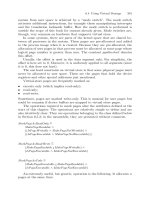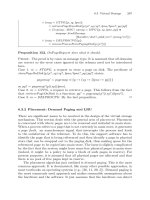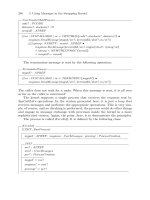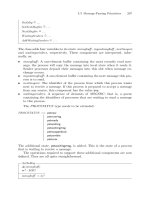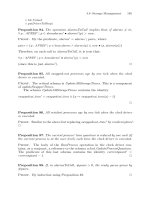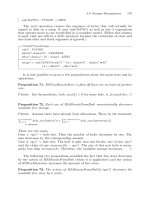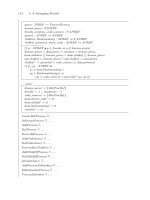Formal Models of Operating System Kernels phần 3 ppt
Bạn đang xem bản rút gọn của tài liệu. Xem và tải ngay bản đầy đủ của tài liệu tại đây (291.81 KB, 39 trang )
114 4 A Swapping Kernel
procs : IPREF ProcessDescr
C
known procs : F IPREF
freeids, zombies, code owners : F APREF
parent : APREF → APREF
children, blockswaiting : APREF → F APREF
childof , parentof , share code : APREF ↔ APREF
(∀ p : APREF • p ∈ freeids ⇔ p ∈ known procs)
known procs = dom procs ∧ zombies ⊂ known procs
dom children ⊆ known procs ∧ dom childof ⊆ known procs
ran childof ⊆ known procs ∧ ran childof = ran parent
childof
∼
= parentof ∧ code owners ⊆ dom parentof
(∀ p
1
, p
2
: APREF •
p
1
∈ dom blockswaiting ∧
p
2
∈ blockswaiting(p
1
) ⇒
(p
1
∈ code owners ∨ parentof
+
(p
1
, p
2
)))
INIT
known procs
= {IdleProcRef }
freeids
=1 maxprocs − 1
code
owners
= {IdleProcRef }
dom shares code
= ∅
dom childof
= ∅
dom blockswaiting
= ∅
zombies
= ∅
CreateIdleProcess
=
IsKnownProcess =
AddProcess =
DelProcess =
DescrOfProcess =
AddCodeOwner =
DelCodeOwner =
ProcessHasChildren =
AddChildOfProcess =
DelChildOfProcess =
IsCodeOwner
=
AddProcessToZombies =
MakeZombieProcess =
ProcessIsZombie =
4.4 Process Management 115
RemoveAllZombies =
KillAllZombies =
GotZombies =
ProcessHasParent =
RemoveProcessFromParent =
ParentOfProcess =
CanGenPId =
NewPId =
releasePId =
AddProcessToTable =
deleteProcessFromTable =
The following operation creates the idle process. The operation sets up
basic data about the idle process, including the status (it will be a ready
process, so can be immediately considered by the scheduler) and process kind
(it is a system process); the operation assigns an arbitrary time quantum
to the process (∞) and its status word is cleared to 0
s
. Next, the storage
areas are created; the idle process does not have any storage (since it does
nothing other than loop), so anything can be assigned (here, empty storage
descriptors are assigned). Then, the idle process’ process descriptor is created
by calling the Init method belonging to its type and the descriptor is stored
in the process table.
CreateIdleProcess
(∃ stat : PROCSTATUS ; knd : PROCESSKIND; schdlv : SCHEDLVL;
tq : TIME ; stwd : STATUSWD; emptymem : MEMDESC ;
stkdesc : MEMDESC ; memsz : N; ipd : ProcessDescr •
stat = pstready
∧ knd = ptuserproc ∧ schdlv = userq
∧ tq = ∞∧stwd =0
s
∧ emptymem =(0, 0)
∧ stkdesc =(0, 0) ∧ memsz =0
∧ ipd.INIT [stat/stat?, knd/knd?, schdlv/slev?, tq/tq?,
stkdesc/pstack?, emptymem/pdata?,
emptymem/pcode ?, emptymem/mem?, memsz /msz?]
procs
= procs ⊕{IdleProcRef → ipd})
It is necessary to generate new process identifiers. The following three
operations are for this purpose. There is a maximum size associated with the
process table: there can, at any time, be a maximum of maxprocs processes in
the table. This is done in this model by manipulating a set of identifiers, as
follows. When an identifier is in this set, it is considered available for use by
116 4 A Swapping Kernel
a new process; when it is not in this set, it is considered to be the identifier
of a process in the process table.
The following schema defines a predicate determining whether there are
any process names that are free. The set freeids contains all those identifiers
that have not been assigned to a process.
CanGenPId
freeids = ∅
NewPId
∆(freeids)
p!:APREF
(∃ p : APREF •
p ∈ freeids
∧ p!=p
∧ freeids
= freeids \{p})
The NewPId operation returns a new process identifier. The predicate can be
simplified, obtaining:
NewPId
∆(freeids)p!:APREF
p! ∈ freeids
freeids
= freeids \{p!}
The operation selects an element of freeids at random, removes it from freeids
and returns it as the next process identifier for use.
releasePId
∆(freeids)
p?:APREF
freeids
= freeids ∪{p?}
This operation returns an identifier to the free pool of identifiers. The identi-
fier, denoted by p?, is added to freeids and, therefore, can no longer be used
as the identifier of a process in the process table, as the class invariant states.
The IsKnownProcess operation is a predicate which tests whether a given
identifier (pid?) is in the set known
procs, the set of known process identifiers.
By the invariant of the class, an identifier is an element of known
procs if and
only if it is not a member of freeids. Therefore, every member of known
procs
is the identifier of a process in the process table.
4.4 Process Management 117
IsKnownProcess
pid?:APREF
pid? ∈ known procs
Process descriptors are added to the process table by the following opera-
tion. In a full model, it would be an error to attempt to add a descriptor that
is already present in the table or to use an identifier that is in freeids.For
present purposes, the following suffices:
AddProcessToTable
∆(procs)
pid?:APREF
pd ?:ProcessDescr
procs
= procs ⊕{pid? → pd ?}
This is an operation local to the ProcessTable. The public operation is the
following:
AddProcess =
newPId
o
9
addProcessToTable
The addition of the identifier generator implies that there is no need to check
the validity of the new process’ identifier (the fact that identifiers are unique
and not in the table should be proved as a property of the model, as is done
below, after the process table’s operations have been defined).
Removal of a process descriptor from the process table is performed by
the following local operation:
deleteProcessFromTable
∆(procs)
pid?:APREF
procs
= {pid?}
−
procs
The deleted process’ identifier is removed from the domain of the procs map-
ping using the domain subtraction operator
−
.
DelProcess = deleteProcessFromTable
o
9
releasePId
The public deletion operation also needs to ensure that the identifier of the
deleted process is released (i.e., is added to freeids).
Throughout the model, access to each process’ process descriptor is re-
quired. The following schema defines this operation. A fuller model, partic-
ularly one intended for refinement, would include an error schema to handle
the case in which the process identifier, pid?, does not denote a value element
of the procs domain (i.e., is not a member of known
procs).
118 4 A Swapping Kernel
DescrOfProcess
pid?:IPREF
pd !:ProcessDescr
pd !=procs(pid?)
Methods for children and zombies now follow.
The owner of a code segment is recorded here. This allows the system to
determine which process owns any segment of code when swapping occurs.
AddCodeOwner
∆(code owners)
p?:APREF
code owners
= code owners ∪{p?}
DelCodeOwner
∆(code owners)
p?:APREF
code owners
= code owners \{p?}
Shared code is important when swapping is concerned. Since there can
be many sharers of any particular process’ code, it appears best to represent
code sharing as a relation.
The following operation declares the process owner? as the owner of a
code segment, while sharer? denotes a process that shares owner?’s code. For
every such relation, there must be an instance in the code
owners relation in
the process table.
AddCodeSharer
∆(code
owners)
owner?, sharer?:APREF
code owners
= code owners ∪{(owner?, sharer?)}
DelCodeSharer
∆(code owners)
owner?, sharer?:APREF
code owners
= code owners \{(owner?, sharer?)}
Zombies and sharing depend upon the process hierarchy. This is expressed
in terms of parent and child processes. The hierarchy is most easily repre-
sented as a relation that associates a parent with its children. The following
4.4 Process Management 119
few operations handle the childof relation, which represents the process hier-
archy in this model.
ProcessHasChildren
p?:APREF
∃ c : APREF •
childof (c, p?)
AddChildOfProcess
∆(childof )
parent?, child?:APREF
childof
= childof ∪ (child?, parent?)
DelChildOfProcess
∆(childof )
parent?, child?:APREF
childof
= childof \ (child?, parent?)
AllDescendants
descs!:F APREF
parent?:APREF
descs!=childof
+
(|{p?}|)
When a process has children in this model, the children processes all share
the parent’s code. If the parent is swapped out, its code segment is transferred
to backing store and, as a consequence, is no longer addressable by the child
processes. Because of this, it is necessary to block (i.e., suspend) all child
processes when their parent is swapped out.
The following schema is satisfied when the process, p?,ownsthecodeitex-
ecutes. Code-owning processes tend not to be descendants of other processes.
IsCodeOwner
p?:APREF
p? ∈ code owners
The operations for handling zombie processes now follow. Zombies are
relatively easy to represent and manipulate in this model.
120 4 A Swapping Kernel
AddProcessToZombies
∆(zombies)
pid?:APREF
zombies
= zombies ∪{pid?}
MakeZombieProcess =
AddProcessToZombies ∧
SetProcessStatusToZombie
ProcessIsZombie
pid?:APREF
pid? ∈ zombies
Operation RemoveAllZombies removes those processes from the children
relation that are related to the zombie process zmb.
RemoveAllZombies
∆(parent, children, zombies)
deadzombs!:F APREF
∃ zmbs : F APREF | zmbs ⊆ zombies ∧ deadzombs!=zmbs •
zombies
= zombies \ zmbs
∧ (∀ zmb : APREF | zmb ∈ zombies ∧ children(zmb)=∅ •
parent
= {zmb}
−
parent
∧ (∃ p : APREF ; descs : F APREF |
p = parent(zmb) ∧ descs = children(p) •
children
= children ⊕{p → descs \{zmb}))
When this operation is used, each zmb has no children. It must be removed
from the parent table and it has to be removed as a child of its parent.
The KillAllZombies operation is defined as follows:
KillAllZombies =
(RemoveAllZombies[dzombs/deadzombies!] ∧
(∀ zmb : APREF | zmb ∈ dzombs •
DelProcess[zmb/p?]))
\ {dzombs}
This operation is performed on a periodic basic. It is called from the clock
process.
The following schema defines a predicate that is true if the set of zombies
contains at least one element. This operation is used in the clock driver.
GotZombies
zombies = ∅
4.4 Process Management 121
ProcessHasParent
p?:APREF
(∃ p
1
: APREF •
parentof (p
1
, p?))
RemoveProcessFromParent
∆(parentof )
parent?, child?:APREF
parentof
= parentof \{(parent?, child?)}
ParentOfProcess
p?:APREF
parent!:APREF
(∃ p
1
: APREF •
parentof (p
1
, p?) ∧ parent!=p
1
)
Note that the initialisation of the system should include a call to the
operation that creates the idle process.
The definition of the ProcessTable class is now complete. It is now possible
to state and prove some properties of this class.
Proposition 34. The identifier of (reference to) the idle process, IdleProcRef,
is unique.
Proof. IdleProcRef = maxprocs. The result follows by the uniqueness of
natural numbers. ✷
Proposition 35. The idle process is unique.
Proof. Each process is represented by:
(i) a unique identifier (its reference);
(ii) a single entry in the process table.
For (ii), procs : IPREF → PD since procs is a function:
procs(x)=procs(y) ⇒ x = y
Therefore, by Proposition 48, the idle process descriptor is unique. ✷
Proposition 36. The identifier NullProcRef never appears in the process ta-
ble.
122 4 A Swapping Kernel
Proof. The domain of procs is IPREF and IPREF ⊂ PREF . NullProcRef ∈
PREF =0 maxprocs, while IPREF =1 maxprocs.SinceNullProcRef =0,
it is an element of PREF but not of IPREF . ✷
Proposition 37. ∀ p : APREF • p ∈ freeids ⇔ p ∈ known
procs.
Proof. This is a conjunct of the invariant. ✷
Proposition 38. NewPId[p/p!] ⇒ p ∈ known
procs
.
Proof.
NewPId
∆(freeids)
p!:APREF
p! ∈ freeids
freeids
= freeids \{p!}
By the invariant:
p ∈ freeids ⇔ p ∈ known procs
By propositional calculus:
p ∈ freeids ⇔ p ∈ known procs
So, if p ∈ freeids ⇔ p ∈ known procs,
freeids
= freeids \{p}
= known
procs ∪{p}
= known
procs
Therefore, p ∈ known procs
. ✷
Proposition 39. NewPId
n
⇒ freeids
= ∅ if n = maxprocs − 1.
Proof. The NewPId operation is:
NewPId
∆(freeids)
p!:APREF
p! ∈ freeids
freeids
= freeids \{p!}
4.4 Process Management 123
Initially, freeids =1 maxprocs − 1, so #freeids = maxprocs − 1.
Now, NewPId
n
=
n times
(NewPId
o
9
NewPId). From the definition of NewPId,
it can be seen that #freeids
=#freeids − 1. Therefore, newPId
n
⇒
#freeids
=#freeids − n.
If n = maxprocs − 1, it is clear that NewPId
n
implies that:
#freeids
=#freeids − (maxprocs − 1)
=(maxprocs − 1) − (maxprocs − 1)
=0
So freeids
= ∅. ✷
Proposition 40. NewPId #freeids
=#freeids − 1.
Proof. By the definition of NewPId, p! ∈ freeids ∧ freeids
= freeids \{p!}.
Therefore:
#freeids
=#(freeids \{p!}
=#freeids − #{p!}
=#freeids − 1
✷
Proposition 41. DelProcess #freeids
=#freeids +1.
Proof. The definition of DelProcess is:
deleteProcessFromTable
o
9
releasePId
The important conjunct is releasePId, whose predicate is:
freeids
= freeids ∪{p?}
The result is immediate:
#freeids
=#(freeids ∪{p?})
=#freeids +#{p?}
=#freeids +1
✷
Corollary 6. deleteProcessFromTable p ∈ known
procs
.
124 4 A Swapping Kernel
Proof. By the definition of deleteProcessFromTable, procs
= {pid?}
−
procs
and known
procs =domprocs. The predicate implies that pid? ∈ dom procs
,
which, in turn, implies that pid? ∈ known
procs. ✷
Proposition 42. If p ∈ known
procs and p
1
= p, the substitution instance
of schema deleteProcessFromTable[p
1
/pid?] implies that p ∈ known procs
.
Proof. By the definition of deleteProcessFromTable:
procs
= {p
1
}
−
procs
The invariant states that dom procs = known procs. Therefore:
dom procs
= dom({p
1
}
−
procs)
= (dom procs) \{p
1
}
= known
procs \{p
1
}
= known
procs
However, by assumption, p = p
1
,sop ∈ known procs. ✷
Proposition 43. Using the definition of NewPId
n
above, the composition
NewPId
n
o
9
DelProcess
m
implies #freeids =#freeids
iff n = m.
Proof. The proof of this proposition requires the following (obvious) lem-
mata.
Lemma 13. If #freeids = n, NewPId
n
implies #freeids =0.
Proof. Since NewPId ⇒ #freeids
=#freeids − 1, then, by induction, for
all n, n ≥ #freeids, NewPId
n
implies that #freeids
=#freeids − n. ✷
Lemma 14. If #freeids = n, DelProcess implies that #freeids
= n +1.
Proof. Immediate from the fact that releasePId implies that #freeids
=
#freeids +1. ✷
Lemma 15. If #freeids =0, then DelProcess
n
implies that #freeids
= n.
Proof. By induction, using Proposition 14. ✷
The proof of Proposition 43 follows immediately from the three lemmata. ✷
Proposition 44. ¬ CanGenPId ⇒¬NewPId.
4.4 Process Management 125
Proof. The operations are defined by the following schemata:
CanGenPId
freeids = ∅
and:
NewPId
∆(freeids)
p!:APREF
p! ∈ freeids
freeids
= freeids \{p!}
Given
¬ canGenPId
freeids = ∅
it is clear that there can be no p s.t. p! ∈ freeds . ✷
Proposition 45. NewPId
n
o
9
releasePId
m
⇒ freeids
= ∅ iff m = n.
Proof. Immediate consequence of Proposition 43. ✷
Proposition 46. There can be no p ∈ APREF such that p ∈ freeids and
p ∈ known
procs.
Proof. By the invariant, p ∈ freeids ⇔ p ∈ known
procs, for all p.Using
propositional calculus, the following can be derived:
1. If p ∈ freeids,thenp ∈ known
procs.
2. If p ∈ known
procs,thenp ∈ freeids.
Therefore, ¬∃p : PREF • p ∈ freeids ∧ p ∈ known
procs. ✷
Proposition 47. NewPId[p
1
/p!]
o
9
NewPId[p
2
/p!] ⇒ p
1
= p
2
.
Proof. The schema for NewPId is:
NewPId
∆(freeids)
p!:APREF
p! ∈ freeids
freeids
= freeids \{p!}
126 4 A Swapping Kernel
By the definition of
o
9
, NewPId[p
1
/p!]
o
9
NewPId[p
2
/p!] is:
∃ freeids
: F APREF •
p
1
∈ freeids ∧ freeids
= freeids \{p
1
}
∧ p
2
∈ freeids
∧ freeids
= freeids
\{p
2
}
This simplifies to:
p
1
∈ freeids ∧ p
2
∈ freeids \{p
1
}
∧ freeids
=(freeids \{p
1
}) \{p
2
}
This is clearly equivalent to:
p
1
∈ freeids ∧ p
2
∈ freeids \{p
1
}
∧ freeids
= freeids \{p
1
, p
2
}
For p
2
∈ freeids \{p
1
} to be the case, p
1
= p
2
, for the reason that
p ∈ freeids{p} for any p. ✷
Proposition 48.
deleteProcessFromTable ⇒ known procs
= known procs \{pid?}
Proof.
deleteProcessFromTable
∆(procs)
pid?:AREF
procs
= {pid?}
−
procs
By the invariant, known procs =domprocs,so:
dom procs
= dom({pid?}
−
procs)
= (dom procs) \{pid?}
= known
procs \{pid?}
= known
procs
✷
4.5 The Scheduler
The scheduler is based on a three-level priority scheme. The basic type is:
SCHDLVL == 1 3
4.5 The Scheduler 127
This type is used to identify queues of waiting processes. The queues are
identified by the following constants:
userqueue, sysprocqueue, devprocqueue : SCHDLVL
userqueue =3
sysprocqueue =2
devprocqueue =1
The first constant, userqueue, denotes the queue of user processes; the second
constant, sysprocqueue, denotes the queue of system processes; and the third,
devprocqueue, denotes the queue of device processes.
Device processes must always be preferred to other processes, so the con-
stant devprocqueue denotes the queue of highest-priority processes. System
processes must be preferred by the scheduler to user processes but should be
pre-empted by device processes, so sysprocqueue denotes the next highest pri-
ority. The constant userqueue denotes the queue of user processes; they have
lowest priority.
In addition, there is the idle process (denoted by the constant IdleProcRef )
which runs when there is nothing else to do. Strictly speaking, the idle process
has the lowest priority but is considered a special case by the scheduler (see the
schema for ScheduleNext), so it appears in none of the scheduler’s queues. (In
the process table, the idle process is assigned to the user-process priority—this
is just a value that is assigned to avoid an unassigned attribute in its process
descriptor.)
The ordering on the priorities is:
devprocqueue < sysprocqueue < userqueue
This property will be exploited in the definition of the scheduler.
queuelevel : PROCESSKIND → SCHDLVL
∀ pt : PROCESSKIND •
(∃ l : SCHDLVL •
queuelevel(pt)=
(pt = ptdevdrvr ∧ l = devprocqueue)
∨ (pt = ptsysproc ∧ l = sysprocqueue)
∨ (pt = ptuserproc ∧ l = userqueue))
As noted above, type ProcessQueue is not defined in terms of QUEUE[X ]
but defined separately. This is because all elements of a process queue are
unique (i.e., there are no duplicates), so the basic type iseq is used rather
than seq.
The class Context is defined so that process context manipulation can
be made simpler. The class accesses the process table, the scheduler (to be
defined shortly) and the hardware registers. The class defines five operations.
128 4 A Swapping Kernel
Context
(INIT , SaveState, RestoreState, SwapIn, SwapOut, SwitchContext)
ptab : ProcessTable
sched : LowLevelScheduler
hw : HardwareRegisters
INIT
ptb?:ProcessTable
shd?:LowLevelScheduler
hwregs?:HardwareRegisters
ptab
= ProcessTable
sched
= LowLevelScheduler
hw
= hwregs?
SaveState =
RestoreState =
SwapIn
=
SwapOut =
SwitchContext =
When an interrupt occurs, SaveState is called to save the state. Then, the
device-specific stuff is executed (this might involve calling SendInterruptMsg).
Finally, the RestoreState method is called to perform a context switch.
SaveState
(∃ cp : IPREF •
sched.CurrentProcess[cp/cp!]
(∃ pd : ProcessDescr •
ptab.DescrOfProcess[cp/pid?, pd /pd !]
∧ (∃ regs : GENREGSET ; stk : PSTACK; ip : N;
stat : STATUSWD; tq : TIME •
hw.GetGPRegs[regs/regs !]
∧ hw.GetStackReg[stk/stk !]
∧ hw.GetIP[ip/ip!]
∧ hw.GetStatWd[stat/stwd!]
∧ sched.GetTimeQuantum[tq/tquant!]
∧ pd .SetFullContext[regs /pregs?, ip/pip?,
stat/pstatwd?, stk/pstack?, tq/ptq?])))
The current process referred to here is not necessarily the same as the one
referred to above. Basically, whatever is in (bound to) currentp runs next.
4.5 The Scheduler 129
RestoreState
(∃ cp : IPREF •
sched.CurrentProcess[cp/cp!]
∧ (∃ pd : ProcessDescr •
ptab.DescrOfProcess[cp/pid?, pd /pd !]
∧ (∃ regs : GENREGSET ; stk : PSTACK; ip : N;
stat : STATUSWD; tq : TIME •
pd .FullContext[regs/pregs!, ip/pip!, stat/pstatwd!,
stk/pstack!, tq/ptq!]
∧ hw.SetGPRegs[regs /regs?]
∧ hw.SetStackReg[stk/stk ?]
∧ hw.SetStatWd[stat/stwd?]
∧ sched.SetTimeQuantum[tq/tquant?]
∧ hw.SetIP[ip/ip?])))
For completeness, we define the SwapOut and SwapIn operations (al-
though they are not used in this book): they are intended to be mutually
inverse.
SwapOut =
(∃ cp : IPREF ; pd : ProcessDescr •
sched.CurrentProcess[cp/cp!]
∧ ptab.DescrOfProcess[pd /pd !] ∧ pd .SetProcessStatusToWaiting)
∧ SaveState
o
9
(sched.MakeUnready[currentp/pid?] ∧ sched.ScheduleNext)
The SwapOut operation uses SaveState and alters the status of the process
concerned. The process is removed from the ready queue and a reschedule is
performed, altering the current process.
SwapIn =
(∃ cp : IPREF ; pd : ProcessDescr •
sched.CurrentProcess[cp/cp!] ∧ pd .SetProcessStatusToRunning
RestoreState)
The SwapIn operation just performs simple operations on the process’ descrip-
tor and then switches the process’ registers onto the hardware and makes it
the current process (i.e., the currently running process).
SwitchContext = SwapOut
o
9
SwapIn
This is a combination operation that swaps out the current process, schedules
and executes the next one.
The organisation of the scheduler implies that the idle process must be
represented by a descriptor in the process table. This is for a number of
reasons, including the need for somewhere to store the kernel’s context.
130 4 A Swapping Kernel
The kernel’s scheduler is called the LowLevelScheduler. It is defined as
follows.
The scheduler has three queues (readyqs), one each for device, system and
user process (in that order). It is worth noting that the process queues are all
contained in the class. This scheme is a multi-level priority queue.
The currently executing process is represented by currentp. The time quan-
tum of the current process is represented by currentquant (if it is a user-level
process). For all processes, the priority is represented by currentplev.
The component prevp refers to the process that executed immediately
before the one currently denoted by currentp.
As already observed, readyqs is an array of queues (represented by a bi-
jection) and nqueues is the number of queues in readyqs (is the cardinality of
readyqs’ domain).
The scheduler is defined at a level in the kernel that is below that at which
semaphores are defined. For this reason, it is important to find another way
to obtain exclusive access to various data structures (e.g., the process table,
a particular process descriptor, the hardware registers or the scheduler’s own
queues). At the level at which the scheduler is defined, the only way to do this
in the present kernel is to employ locking. For this reason, the class initialises
itselfwithaninstanceofLock.
LowLevelScheduler
(INIT , GetTimeQuantum,
SetTimeQuantum, RunIdleProcess,
CurrentProcess, MakeReady,
UpdateProcessQuantum, MakeUnready,
ContinueCurrent, ScheduleNext)
currentp : IPREF
currentquant : TIME
currentplev : SCHDLVL
prevp : IPREF
nqueues : N
1
readyqs : SCHDLVL → ProcessQueue
C
lck : Lock
ctxt : Context
proctab : ProcessTable
hw : HardwareRegisters
nqueues =3
#readyqs = nqueues
4.5 The Scheduler 131
INIT
lk?:Lock
ptb?:ProcessTable
hwrs?:HardwareRegisters
lck
= lk ?
proctab
= ptb?
currentp
= NullProcRef
currentquant
=0
currentplev
= userqueue
prevp
= NullProcRef
prevplev
=1∧ hw
= hwregs?
GetTimeQuantum =
SetTimeQuantum =
RunIdleProcess =
CurrentProcess =
MakeReady =
UpdateProcessQuantum =
MakeUnready =
reloadCurrent
=
ContinueCurrent =
ScheduleNext =
runTooLong =
allEmptyQueues =
selectNext =
The operations defined for the scheduler can now be described.
User processes are associated with a time quantum. This is used to de-
termine when a user process should be removed from the processor if it has
not been blocked by other means. The current time quantum must be copied
to and from the current process’ descriptor in the process table. It must be
possible to assign currentquant to a value. The following pair of operations
specify these operations.
The first returns the value stored in the time quantum variable. This value
represents the time quantum that remains for the current process.
GetTimeQuantum
tquant!:TIME
currentquant = tquant!
132 4 A Swapping Kernel
The second operation sets the value of the current process’ time quantum;
this operation is only used when the current process is a user-defined one.
When a user process is not executing, its time quantum for a process is stored
in its process descriptor.
SetTimeQuantum
tquant?:TIME
(∃ pd : ProcessDescr; lv : SCHDLVL •
proctab.DescrOfProcess[currentp/pid?, pd /pd !]
∧ pd .ProcessLevel[lv /lev!]
∧ ((lv = userqueue ∧ currentquant
= currentquant − tquant?)
∨ currentquant
=0))
When there are no other processes to execute, the idle process is run.
RunIdleProcess
∆(currentp)
currentp
= IdleProcRef
billp
= IdleProcRef
This schema defines the operation to select the idle process as the next process
to run. Note that it does not switch to the idle process’ context because the
code that calls this will perform that operation by default.
When a process is swapped off the processor, its identifier must be retrieved
from currentp. The following schema defines that operation:
CurrentProcess
cp!:IPREF
cp!=currentp
With the MakeReady, we have come to the core set of scheduler operations.
This operation adds the process named by pid? to the ready queue at the
appropriate priority level.
The MakeReady operation first locks everything else out of the processor.
It then obtains the process descriptor for the process referred to by pid?. The
priority of this process is extracted from its process descriptor and the process
is enqueued on the appropriate queue. (Actually, the pid?—a reference to the
process—is enqueued.) Finally, the operation unlocks the processor.
4.5 The Scheduler 133
MakeReady
∆(readyqueues)
pid?:IPREF
lck.Lock
o
9
(∃ pd : ProcessDescr; lv : SCHDLVL •
proctab.DescrOfProcess[pd /pd !]
∧ pd .ProcessLevel[lv /lev!]
∧ pd .SetProcessStatusToReady
∧ (readyqueues(lv).Enqueue[pid?/x ?]
∧ lck .Unlock)
Proposition 49. For any process, p, at priority level, l, MakeReady[p/pid ?]
implies that:
#readyqueues
(l)=#readyqueues(l)+1
Proof. The critical line in the predicate is:
readyqueue(l).Enqueue[p/x ?]
The definition of Enqueue, after substituting p for x ?, is:
elts
= elts
p
So:
#elts
=
#(elts
p)=
#elts +#p =
#elts +1
✷
Operation UpdateProcessQuantum updates the time quantum in a process
descriptor, provided that the process is a user-level one. The quantum (stored
in currentquant) is decremented by one to denote the fact that the process
has just executed.
UpdateProcessQuantum
(∃ pd : ProcessDescr; lv : SCHDLVL •
proctab.DescrOfProcess[currentp/pid?, pd /pd !]
∧ pd .ProcessLevel[lv /lev!]
∧ ((lv = userqueue
∧ currentquant
= currentquant − 1
∧ ((currentquant
≤ minpquantum ∧ runTooLong)
∨ (currentquant
> minpquantum ∧ ContinueCurrent)))
∨ Skip))
134 4 A Swapping Kernel
This operation deals with the case in which a user process has run for too
long a period. Its operation is very much as one might expect.
runTooLong
(∃ p : APREF •
readyqueues(userqueue).RemoveFirst[p/x !]
o
9
(readyqueues(userqueue).Enqueue[p/x ?]
o
9
(prevp
= currentp ∧ ScheduleNext)))
This is called by the clock driver (Section 4.6.4) to cause pre-emption of the
current user process.
Proposition 50. UpdateProcessQuantum implies that if currentp’s priority
is userqueue and currentquant > minpquantum, then currentp
= currentp.
Proof. By the predicate, if currentquant
> minpquantum, ContinueCurrent
is executed. The predicate of ContinueCurrent contains currentp
= currentp
as a conjunct. ✷
Proposition 51. If there are no processes of higher priority in the scheduler’s
ready queue, UpdateProcessQuantum implies that currentp
= currentp if the
user-level queue only contains process p.
Proof. Let readyqueues(userqueue)=p. The predicate of runTooLong is
(in shortened form): RemoveFirst
o
9
Enqueue.Thisimpliesthatelts = elts
if
elts = p.
The sequential composition expands into:
∃ elts
:iseqAPREF ; x !:APREF •
x!=head elts
∧ elts
= tail elts
∧ elts
= elts
x!
This simplifies to elts
=(tail elts)
head elts.Ifelts = p, tail elts = ,
and:
elts
=(tail elts)
head elts
=
head elts
=
(headx )
=
x
= x
= elts
By selectNext, currentp
= p since selectNext contains QueueFront as a con-
junct and QueueFront is defined in terms of head elts. ✷
4.5 The Scheduler 135
Proposition 52. Assuming there are no processes of higher priority in the
ready queue, if the level of the executing process is userqueue and
currentquant ≤ minpquantum
then
currentp
= head readyqueues(userqueue)
if #readyqueues(userqueue) > 1.
Proof. Assume that the queue readyqueues(userqueue) is of length greater
than 1. Then head elts = currentp and head tail elts = currentp.Bythecom-
position RemoveFirst
o
9
Enqueue, elts
=(tail elts)
currentp. Since there are
no duplicates in elts,thisimpliesthatcurrentp
= head tail elts
= currentp. ✷
The MakeUnready operation is another key operation. Its intent is to re-
move the process denoted by pid? from the ready queue. What happens to the
process thereafter is a matter for the caller of MakeUnready.TheMakeUn-
ready operation does not manipulate the context of the victim process because
it is not clear what that state is; instead, it just removes the process from the
queue. If the process is the head of its queue, it is removed and a rescheduling
operation occurs; otherwise, the process is just removed.
The operation removes any process reference that is in the queue. The
reference can be the head of the queue or somewhere inside the queue. What
happens to the reference that is removed is a matter for the user of this
operation. Typically, the process reference is enqueued on another queue (e.g.,
a device queue or the clock). Because what is to happen to the removed
process cannot be determined, the MakeUnready schema contains no reference
to operations manipulating the representation of the process’ state in the
process descriptor. (The reader should note that RemoveElement will also
remove the head of the queue—the schema is written to be as clear as possible.)
MakeUnready
pid?:APREF
(∃ q : ProcessQueue; pd : ProcessDescr; lv : SCHDLVL •
proctab.DescrOfProcess[pd /pd !]
∧ pd .ProcessLevel[lv /lev!] ∧ q = readyqueues(lv)
∧ (¬ q.IsEmpty
∧ (∃ f : APREF •
q.QueueFront[f /x!]
∧ (f = pid? ∧ (q.RemoveFirst
o
9
q.selectNext[q/q?, lv/lev?]))
∨ q.RemoveElement[pid?/x ?])))
136 4 A Swapping Kernel
Proposition 53. If a process, p, has priority l, and is in the ready queue,
then MakeUnready[p/pid?] implies that:
#readyqueues
(l)=#readyqueues(l) − 1
Proof. There are two cases to consider: in the first, p is at the head of the
queue and in the other, p is not at the head.
In both cases, let readyqueues(l)=elts.
Case 1. In the predicate, f = p or p = head elts,soelts = p
elts
. Then:
#elts =
#(p
elts
)=
#p +#elts
=
1+#elts
So #elts
=#elts − 1.
Case 2. p = head elts. Therefore:
∃ s
1
, s
2
:iseqAPREF •
elts = s
1
p
s
2
∧
elts
= s
1
s
2
Therefore:
#elts =
#(s
1
p
s
2
)=
#s
1
+#p +#s
2
=
#s
1
+1+#s
2
=
1+#s
1
+#s
2
=
1+#elts
✷
Proposition 54. Let q be readyqueues(p
r
), where p
r
is the priority of process,
p. If p is an element of q, then MakeUnready[p/pid?] implies that p is not
an element of q
.
Proof. There are two cases to consider:
Case 1. Process p is the head of q. The appropriate conjunct of MakeUnready
is:
q.QueueFront[f /x!]
∧ (f = pid? ∧ q.RemoveFirst)
The predicate of RemoveFirst is:
4.5 The Scheduler 137
elts
= tail elts
which is equivalent to:
elts = p
elts
from which it is clear that p is not an element of elts
; hence, p cannot be an
element of q
.
Case 2. Process p is not the head element of q. Therefore, in MakeUnready,
f = pid?, so q.RemoveElement[pid?/x?] is required. The RemoveElement’s
predicate is:
∃ s
1
, s
2
:iseqAPREF •
s
1
pid?
s
2
= elts
∧ s
1
s
2
= elts
It is again immediate that p cannot be an element of elts
and, hence, not of
q
. ✷
reloadCurrent
∆(currentp, prevp)
currentp
= currentp
prevp
= prevp
ContinueCurrent
=
reloadCurrent ∧ ctxt.RestoreState
This operation is really just the identity on the scheduler’s state. The intent is
that the current process’ execution is continued after a possible rescheduling
operation. If the rescheduling operation determines that the same process be
continued, the operation specified by this schema is performed.
The scheduler needs to determine whether all of its queues are empty. The
following schema defines this test:
allEmptyQueues
∀ i : SCHDLVL •
readyqueues(i).IsEmpty
If all the queues are empty, the idle process must be run.
The selectNext operation is a central part of the scheduler.
138 4 A Swapping Kernel
selectNext
(∃ q : ProcessQueue •
q = readyqueues(devprocqueue)
⊗readyqueues(sysprocqueue)
⊗readyqueues(userqueue)
∧ (∃ p : APREF ; l : SCHDLVL; pd : ProcessDescr •
q.QueueFront[p/x!]
∧ proctab.DescrOfProcess[p/pid?, pd /pd !]
∧ pd .SchedulingLevel[l/sl!]
∧ prevp
= currentp
∧ currentp
= p
∧ currentplev
= l))
The schema first concatenates the three queues so that the head can be de-
termined. This is licensed by the fact that, for any sequence, injective or not,
q = q. The process at the head of the queue is determined and its prior-
ity is obtained from the process descriptor. The current and previous process
variables are updated, as is the record of the current process’ priority. The
priority, currentplev, is only of significance when it is userqueue: in this case,
pre-emption using time quanta is employed.
Proposition 55. If:
q = readyqueues(devprocqueue)
⊗readyqueues(sysprocqueue)
⊗readyqueues(userqueue)
then 0 ≤ #q ≤ maxprocs − 1.
Proof. The element type of readyqueue(i), i : SCHDLVL,isAPREF .There
can be a maximum of maxprocs − 1elementsinAPREF.Ifall processes in
the system are readied, they will be in exactly one of the queues, depending
upon priority. Since q is the concatenation of all priority queues, its maximum
length is therefore maxprocs − 1.
If, on the other hand, there are no ready processes (and the idle process
is the next to run), readyqueues is empty for all i : SCHDLVL,so#q =0.✷
Finally, we reach ScheduleNext. This is the scheduling operation.
ScheduleNext
=
(allEmptyQueues ∧ RunIdleProcess)
∨ selectNext
If all scheduler queues are empty, the idle process is executed; otherwise,
another process is selected for execution. It should be noted that this operation
must always be executed in a locked context: it is called either in an ISR or
in the body of a semaphore.


